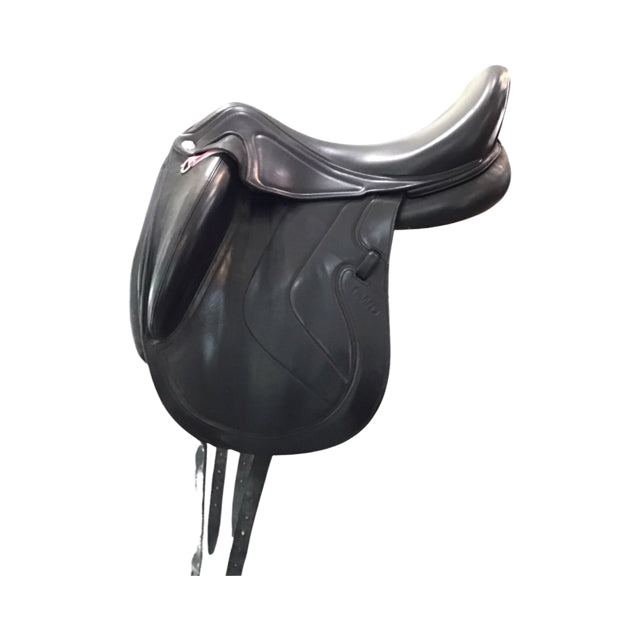Saddle Guide - Type, Size, and More!
GUIDE TO ENGLISH SADDLES What kind of saddle do you ride in?
TYPES OF SADDLES AND THEIR PHYSICS
ALL PURPOSE SADDLES - Riding in an all-purpose saddle puts the rider in a protective or defensive position. The stirrup bar is farther away from the deepest part of the seat of the saddle. This design causes your leg to be out in front of your upper body. By having your leg out in front of your body it makes it more difficult to fall forward off of your horse. In an all-purpose saddle, no matter how hard you try you will not be able to put your leg under you for a proper equitation position. Riders on all-purpose saddles generally ride with shorter stirrups. The flaps on all-purpose saddles are set farther forward in order for your knees to not stick out off of the flaps. Riders compensate for this by leaning a bit more forward to balance. This type of saddle usually has a round cantle, a deeper seat and knee rolls. All-purpose-saddles are used mainly for trail riding, recreational riding, fox hunting and cross-country horseback riding. These kinds of saddles are comfortable for long rides.
CLOSE CONTACT SADDLES are designed for classic equitation. The body lines that determine this are: Shoulder – Hip – Heel & Knee – Toe. What this means is that when you are seated in a saddle on a horse, you will be able to draw a straight line from your shoulder through your hip ending at your heel. You will at the same time be able to draw a line from the front of your knee to the tip of your toe. The close contact saddle’s stirrup bars are installed closer to the deepest part of the seat of the saddle to make proper equitation possible.
DRESSAGE SADDLES have the stirrup bars directly under your seat. This allows your leg to be open at the hip, almost standing while riding. Dressage riders sit far more upright than any other English rider and need to have as much leg as possible against their horses. The flap of the dressage saddle is straight down from the stirrup bar. This style accommodates a longer stirrup length and a straighter leg. Deep seats, round and high cantles, as well as long, straight flaps, characterize dressage saddles.
________________________________________________________________________________________________________
WHAT'S INSIDE A SADDLE
Saddle Panels
Panels are two cushions that are underneath the saddle divided by a channel that gives a comfortable padded surface to the horse’s back while raising the tree high enough to give easy clearance of the animal’s spine. The panels disperse the rider’s weight over a larger surface, thereby protecting the horse from the weight of the rider. These panels also protect the horse’s back from the hardness of the saddle.
Panels
1. Saddles are stuffed with foam, felt, wool, air bladders and any combination of the 3.
2. Detect the material by inspecting the underside of the panels.
3. Gusseted panel are generally wool flocked/stuffed.
4. Wool stuffing is replaceable- foam is not.
________________________________________________________________________________________________________
SOME REASONS HORSES GET BACK SORE
Saddle Tree is too narrow.
Saddle Tree is too wide.
Saddle is too small for the rider.
Improper saddle pad.
Incorrect Bit.
________________________________________________________________________________________________________
SADDLE TREES
A saddle tree is the frame on which the saddle is built. Its shape determines the shape of the saddle, which varies from the flat-race tree weighing only a few ounces to the modern dip-seated spring tree. Ideally, the tree should be built to fit the back of the horse for which the saddle is intended. Most of the time, however, saddles are manufactured for certain sizes and shapes and will fit most horses of equivalent sizes and shapes.
Trees are usually made in three width fittings:
Narrow, medium, and broad
Four lengths: 15 inches, 16 inches, 16 1/2 inches and 17 1/2 inches
38.1, 40.64, 41.9, and 44.45 centimeters respectively
________________________________________________________________________________________________________
TREE MATERIALS
Fiberglass and Wood
________________________________________________________________________________________________________
ADJUSTABLE TREE
What are they for? Adjustable trees are for the finer adjustment of a saddle. Generally they adjust from extra narrow to extra wide.
What are NOT for? Adjustable trees are not for fitting more than one horse by changing the tree regularly. All interior structures strip and break with over use.
WHAT ARE THE DIFFERENT STYLES OF ADJUSTABLE TREES
Interchangeable trees that switch the gullets out.
Adjustable tree saddles have a mechanism that widens or narrows the tree.
________________________________________________________________________________________________________
HOW TO FIT A SADDLE - RIDER MATH
ENGLISH SADDLE SIZES -
Child’s 12”-13”-14”-15”15 3/4”-16”
Adult’s 16” -16” 1/2 - 17”- 17 1/2”- 18”- 18 1/2” - 19”
SEAT TO LEG RATIO - SEAT SIZE & FLAP SIZE
1. Determine what discipline that you will be riding.
2. Look at your body type to determine if you are long from hip to knee. A long thighbone requires a forward and or longer flap. Be sure that when your leg is in the correct position you are on the flap.
3. Determine what size your saddle seat needs to be by sitting in a variety of saddles. A hand sideways (four fingers) behind your seat is a good measurement.
4. Many people choose to ride in a saddle that is too small often because that is the size they fit into as a teenager. Be sure the saddle is comfortable for your seat, leg and crotch.
5. You are serving your horse best by sitting in the deepest part of the saddle seat and your weight should not be over the cantle of the saddle. Riding in a saddle that is too small puts pressure on a horse’s back and will cause back issues.
6. Be SURE to sit the saddle properly balanced on the saddle buck. The seat needs to be level so that you are not falling forward on your crotch or back too far on your seat bones.
STIRRUP BAR TO SEAT RATIO - FLAP POSITION
What kind of riding you choose to participate in will determine what style of English saddle you buy. English saddle designs are based on physics. Where the stirrup bar is in relation to the deepest part of the saddle will influence where your leg hangs below it. The farther forward the stirrup bar the more in front of you your leg will be. Saddles are measures from the button on the front of the saddle to the center of the cantle.


